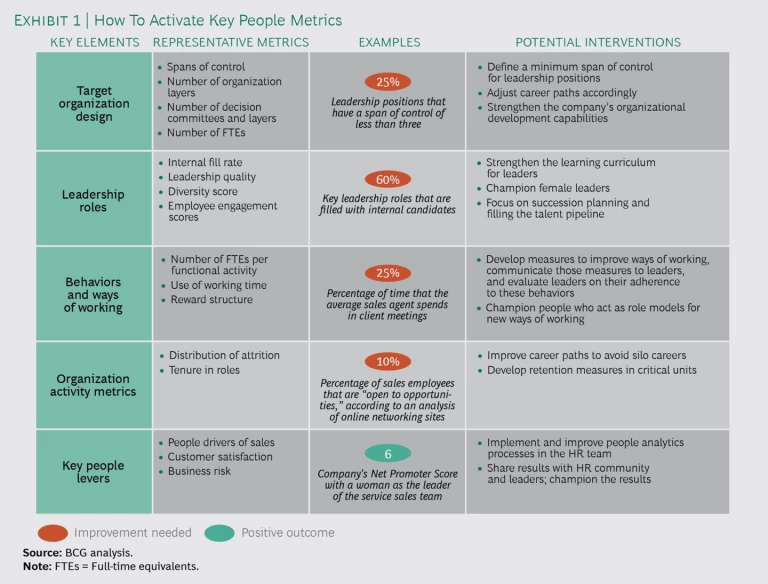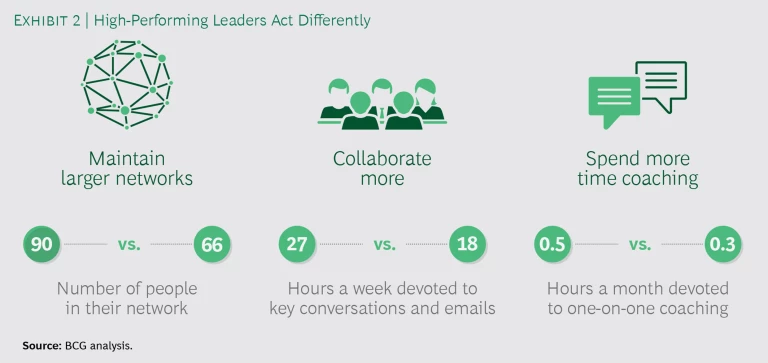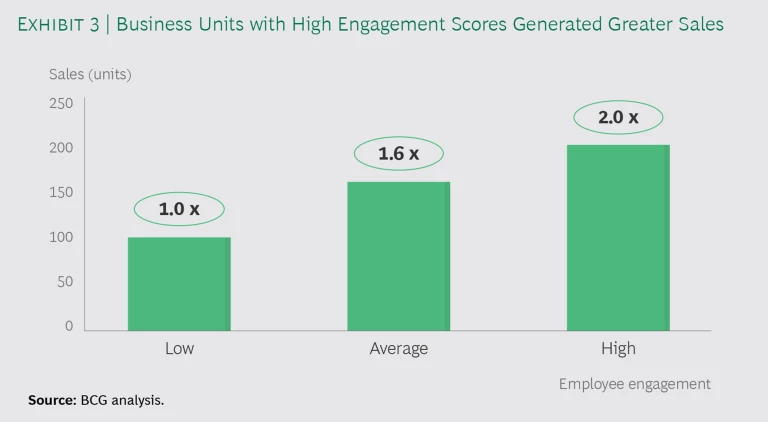In today’s fast and fluid world, business transformation is a necessity, not an elective. To transform, organizations must embark on three parallel journeys:
- Activating, aligning, energizing, and equipping leaders to inspire and drive the change
- Embedding new governance and adaptive end-to-end program management practices to ensure rapid change
- Engaging and empowering employees in real time through transparent multiway communications
More than ever, facilitating people’s journeys is critical to changing behaviors and ways of working to make the transformation stick. The rising adoption of agile, design thinking, and other digitally oriented practices demonstrates the increasing importance of these changes.
Successful transformations set specific goals and implement clear methods for measuring progress. In the past, organizations undergoing transformations relied on quantitative scorecards to assess financial and operational results, but they employed qualitative measures to evaluate people. It was therefore difficult to generate reliable and insightful data about the financial impact of people’s performance.
People analytics has changed the game, with engines that can generate quantitative behavioral data on what people do at work, how a transformation will affect their work, and how changes in behavior can improve financial performance.
People analytics engines are built on a foundation of simplicity and standardization so that the insights are understandable and actionable. This allows executives to track progress against a baseline and link performance to cultural and people dimensions.
Properly deployed, people analytics can help unlock the full force of a business transformation and spur leaps in performance. In particular, five fundamental people analytics questions can help set the stage for a successful transformation:
- Is the target organization design sufficiently simple, lean, and customer focused?
- Are leadership roles well designed and staffed, with sufficient attention to diversity of the leadership team and overall employee engagement?
- Will the transformation help create the desired behaviors and ways of working, and are those behaviors and ways clearly articulated?
- Are organization activity metrics, such as attrition rates and internal job rotation frequency, being used to support the transformation?
- For the most critical parts of the business, what are the key people levers that most influence performance?
Depending on their transformation goals, organizations may modify these questions. Whatever the specific questions, they should almost certainly focus on elements that influence behavior, such as performance management systems and HR processes. The art of changing behavior lies in identifying the handful of simple and measurable people analytics elements that can put the power of an organization’s people behind its transformation. An organization may change these elements over time as a transformation unfolds.
Target Organization Design
It’s time to put design back in organization design. The modern organization has become increasingly complex. Intricate and intersecting solid and dotted lines represent the added accountabilities and dimensions of business activity—new digital businesses, centers of excellence, external partnerships, and so on.
Many transformations, especially those oriented around agile and customer journeys, aim to reduce this complexity and refocus the organization on the customer and end user. There is no shortage of KPIs, role charters, and other mechanisms to guide and track organizational behavior. In the quest to be on the cutting edge of practice, however, organizations should not lose sight of the tried-and-true metric of spans of control. (For an overview of potential metrics, see Exhibit 1.) The ratio of managers to direct reports remains the single best test of whether a design is top heavy. The number of layers and the number of leadership positions remain a strong measure of organizational effectiveness. Too many layers and leadership positions can hurt both financial performance and customer satisfaction by 10% to 15%.
With a few exceptions, organizations should strive to ensure that leaders have an average span of control of eight when they are managing functions driven by expertise and skill. Spans may be even higher when overseeing transactional functions. In many organizations, however, about 60% of leaders have five or fewer direct reports. Low spans are generally not deliberate but a second-order consequence of inadequately defined leadership roles and career paths.
Leadership Roles
In an organization with proper spans of control, managers do not have the time to micromanage or make individual contributions. Their job is to coach and set direction. With fewer leaders in place, organizations need to ensure that they have selected the right people for these roles and are providing adequate support. Organizations that reduce the number of leaders may end up spending more on leadership training and development and external recruitment of leaders. Effective training increases leadership quality by 5% to 15%.
Companies should also look to outside hires to infuse new ideas. Some companies push for external recruits to constitute 10% or even more of the total workforce, depending on the business model and strategy. Other companies pull up rising stars with fresh ideas from lower levels of the organization. This has become an increasingly popular strategy with the rise of digitization.
Leaders, especially those in the middle of an organization, are critical during a transformation. They are responsible for execution, communication, and inspiration. They also need to deal with the expectations and anxieties of their direct reports. That’s why leadership metrics are so important. These metrics should be based on honest assessments of quality, rather than the once-popular forced-distribution method of placing leaders along a hypothetical bell curve. Companies should devote significant effort to strengthening the skills of lower-ranked leaders.
Effective leadership teams are diverse leadership teams. In a recent study conducted by BCG and the Technical University of Munich, companies with diversity scores above the median generated, on average, 38% more of their revenues from new innovative products and services than companies with scores below the median. Gender, ethnicity, experience, and national diversity are all important; if organizations ignore diversity during a transformation, they will set their diversity and transformation efforts back by years.
After a transformation, leaders continue to play critical roles. Leadership quality, for example, is the biggest driver of employee engagement, which typically accounts for 15% to 20% of revenue and customer satisfaction.
Behaviors and Ways of Working
Organization design and leadership can only go so far during a transformation. The ultimate success of a transformation depends on changing behaviors and ways of working. Changing behaviors requires more than telling people to alter how they act. It demands modifying the organization operating system that causes people to act the way they do. Changes in leadership profiles, performance management systems, and even IT systems all come into play.
Quantitative data can help reveal inefficiencies and ineffective ways of working. For example, the amount of time devoted to certain meetings may be disproportionate to the relative importance and decision rights of those meetings. More broadly, executives who spend more than one-third of their time in internal meetings—or sales executives who spend less than two-thirds of their time with clients—are generally ineffective in their jobs. Many current ways of working derive from outdated business models, habit, or inertia. During a transformation, leaders need to understand the context that led to a particular set of behaviors. They must then clearly define the target behaviors and ways of working and change the context, resources, and incentives to realize the new ways of working. (See Exhibit 2.)
Organization Activity Metrics
Attrition and churn are healthy ways to bring in new blood and flush out old ways of working but can jeopardize a transformation if they rise too much or too quickly or are too low. For example, annual turnover of less than 5% creates seniority, experience, and stability but not necessarily a strong mix of backgrounds or internal opportunities. Meanwhile, attrition rates of more than 10% could create frequent handoffs and other transactional costs that challenge both internal and external clients and partners. (The 10% level is not ironclad. Depending on an organization’s business model, industry, labor market, and ways of working, higher levels of attrition might be acceptable.) The same dynamic is true for internal moves between roles. An average tenure of less than two years in sales positions hurts customer experience scores because employees do not have the time to build client relationships and gain expertise.
Although organizational activity is often either dismissed as status quo or even overlooked, it can be managed to create value. By adjusting attrition rates and rotation frequency, companies can become more effective and efficient, improve customer satisfaction, and speed up processes and delivery times.
The optimum time an employee spends in a role should be determined objectively—from the customer’s perspective, for example, rather than by the employee’s preference. At one organization, sales employees wanted to change roles internally every one-and-a-half years, for example, while customers wanted relationships to last three or four years.
Cost and productivity also come into play. During the first three months in a role, employees rarely add value to the business. If an employee stays in a job for only one-and-a-half years, a company loses the productive equivalent of about 8% of a full-time employee who stays for at least three years.
Key People Levers
People analytics can identify the levers that most effectively improve performance and amplify the effects of a transformation. In one company with an ambition to become more customer centric, the analytics showed that the organization could improve customer satisfaction by 21% by encouraging staff to stay longer in their positions, reducing attrition through better leadership, and naming more women to run business units. (Women outperformed their male counterparts by 15% in internal rankings.)
Another company, struggling with high attrition in customer-facing roles, relied on people analytics to show that a more balanced workload could reduce attrition by 15% and improve customer loyalty scores by 7 percentage points. Moreover, increasing employee engagement could improve sales performance by 19%. Business units with high engagement had twice the sales volume, compared with units with low engagement. (See Exhibit 3.)
People analytics can also identify counterintuitive findings. For example, a company that rotated its best and brightest stars into international assignments discovered that those roles increased attrition by 12% and reduced the odds of getting promoted by 18%. Other companies have discovered that 15% of employees are responsible for more than 90% of cyber risks and fraud in general.
A transformation that does not change behaviors and ways of working is unlikely to succeed. People analytics offers a fact-based approach to addressing these hard-to-quantify issues.
People analytics data is most effective when it is collected and used over time, rather than episodically, and when it is combined with business outcome data—such as costs, productivity, and customer satisfaction—and other data collected during the course of a transformation. This triangulation helps generate critical insights that would not be available by reviewing each individual data silo.
By focusing on the five key elements of people analytics, organizations can improve the odds that they can change behaviors and ways of working during a transformation and help ensure that their people will stay engaged and productive throughout the initiative. In addition to the financial benefits to companies and shareholders, and the greater customer experience provided, changing behaviors and ways of working also helps create workplaces where employees can thrive.
Keeping it simple and focused will help to support a company’s transformation.









